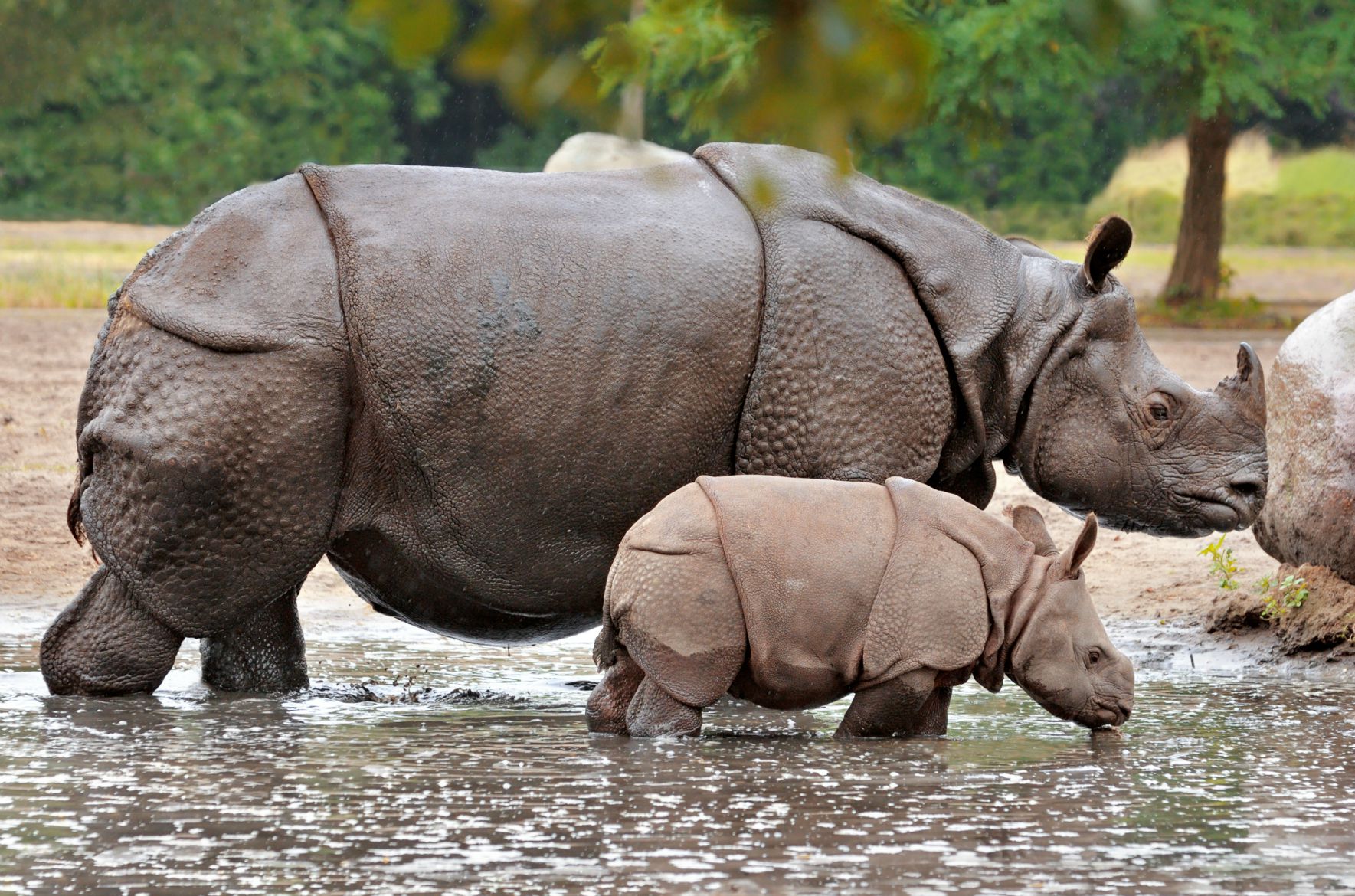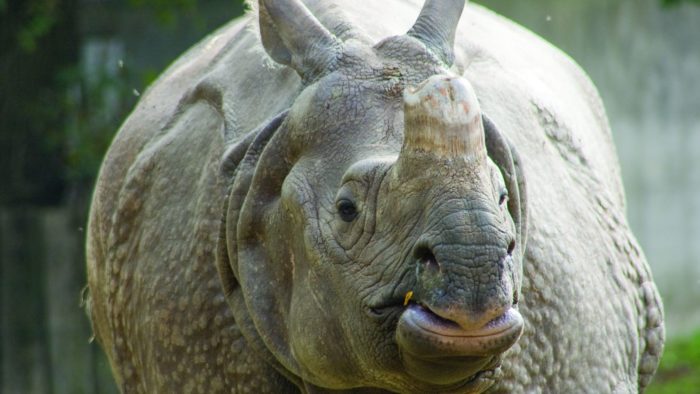The greater one-horned rhino or Indian rhino is the largest in size of the four rhino species that exist in the world today. (The last member of the fifth species - the Sumatran Rhino died in December last year). It has a single black horn about 8-25 inches long and a grey-brown hide with skin folds, which makes it look like an armour-plated warrior. Solitary by nature, adult males gather together only in adulthood to graze or at wallows. Their diet consists of grass, leaves, branches, shrubs, trees, fruit and aquatic plants.
A species that once roamed the entire northern part of the Indian sub-continent, almost disappeared as they began to be hunted for sport or killed for intrusions into human territory. The International Rhino Foundation says this pushed the species very close to extinction and by the start of the 20th century, only around 200 wild greater one-horned rhinos remained.
An IRF team member Jack Hanna has said “A century ago, maybe as many as a million rhinos roamed the earth. Today that number is less than 30,000, so the fight for survival was never more important than it is now!” and India is at the forefront of the challenge of protecting the rhino.
While the world has watched Project Tiger closely, it has almost missed seeing the recovery of the greater one-horned rhino counted among the greatest conservation success stories in Asia.
Launched in 2005, Indian Rhino Vision 2020 was an ambitious effort to attain a wild population of at least 3,000 greater one-horned rhinos spread over seven protected areas in the Indian state of Assam by the year 2020. Today, with Vision 2020 nearly complete, the greater one-horned rhino has come back from the brink. There are nearly 3,500 rhinos in north-eastern India and the Terai grasslands of Nepal.
IRF partnered with the Assam Forest Department, the Bodoland Territorial Council, the World Wide Fund for Nature (WWF), and the US Fish & Wildlife Service to address the threats facing Indian rhinos. IRF is moving rhinos from overcrowded areas, like Kaziranga National Park and Pabitora Wildlife Sanctuary, to other protected areas where they can breed. Along with continuing strict protection and community engagement, IRF says Indian rhinos out among more protected areas will create a larger, safer, and more stable population.
Building on the success of this 15-year program, partners will gather in the coming months to evaluate the completed IRV2020 plan and determine next steps to ensure the survival of the greater one-horned rhino in India and Nepal.

CSP spoke with Bibhab Kumar Talukdar, Secretary General and CEO of Aaranyak and Asia Coordinator of International Rhino Foundation and Chair of IUCN/SSC; Asian Rhino Specialist Group.
Bibhab Talukdar is among the rare humans who has seen all the existing species of rhinos in the world. All the five species rhinos are unique in their behaviour, habitat they use and distribution range in the world. He says that while seeing white or black rhinos in the wilderness of Africa and greater one horned rhino in the wilderness of India and Nepal is easy as they use in open areas which is easier to see, seeking Sumatran and Javan Rhinos in dense forest, where visibility is poor is always challenging.
Javan and Sumatran rhinos are sensitive to human presence and as soon as they get a smell of humans or presence of humans, they go into hiding. Bibhab saw his first Javan rhino in Ujung Kulon National Park in September 2017 after he made 32 trips into the National Park. A reward for his love for the gentle beast.
Bibhab started his organisation Aaranyak in 1989 when he completed his B.Sc. exam and was waiting for his results. Fascinated by WWW-India’s Nature Club movement and its Panda logo he was inspired to start an NGO to do work locally. He wrote to the WWF-India Mumbai office which sent him the form for affiliation. And so was born Aaranyak Nature Club.
The name Aaranyak was coined by Prof. Dinesh Baishya, who taught him in the Zoology Department of B. Barooah College. The name refers to luxuriant forests and Bibhab says it also sounds indigenous in the context of Northeast India bestowed with rich biodiversity along with cultural diversity.
Aaranyak is a recognized Scientific and Industrial Research Organization (SIRO) by the Department of Scientific and Industrial Research (DSIR) of the Ministry of Science and Technology, Government of India and recipient of Indira Gandhi Paryavaran Purashkar 2012 from the Ministry of Environment, Forests and Climate Change, Government of India and Recipient of 2017 State Awards for Scientific Excellence as a scientific institution from the Government of Assam.

In this interview with CSP, India’s senior most Rhino expert Bibhab Kumar Talukdar talks about Vision 2020.
What is the status of Vision 2020 of the Indian one horned rhino? What are the key strategies that helped in achieving its goals?
The Indian Rhino Vision 2020 was launched in 2005 with an aim to increase the greater one horned rhino population in Assam to 3000 by year 2020 and to increase the area of rhino occupancy within Assam through translocation. Under the IRV 2020 till 29th February 2020, 20 rhinos were captured and translocated to Manas National Park of Assam since 2008. Ten rhinos were captured from Pabitora Wildlife Sanctuary and another 10 were captured from Kaziranga National Park during 2008-until February 2020.
What is unique about the Indian Rhino and what special care does it require?
The greater one horned rhino which is also known as Indian Rhino is one of the five rhino species still surviving in the wild. This species was down-listed in IUCN Redlist from Endangered Category to Vulnerable Category of threats in 2008 due to overall improvement in its population growth and conservation measures in place which is indeed a success story. The greater one horned rhino is a grazer and as such scientific management of grassland has been practiced by forest officials to keep grasslands as grasslands and check succession to woodlands. Wetlands are also crucial for rhinos and grasslands near to a wetland often provide good grazing for rhinos and other herbivores and to allow wallowing.
Besides habitat management, rhino is a protection dependent species as illegal gang of wildlife smugglers hunt rhinos for their horn. As such stringent protection mechanism and early intelligence gathering is very important.
Why is Kaziranga special? Have you been able to relocate rhinos to other places successfully?
Kaziranga is special, because of its location being in alluvial flood plains, its grassland habitats along with wetlands and tree forests giving unique opportunities for many threatened wildlife to utilise the space. It is indeed one of the best managed national park not only in India, but in the world. The park harbours some of the threatened species like greater one horned rhino (about 60% of global wild population is found in Kaziranga), Tiger (about 110-120 numbers), elephant about 800, Eastern Swamp Deer about 1000, Wild Buffalos about 1000 and over 500 species of birds.
Rhinos were relocated from Kaziranga to Manas National Park as part of Indian Rhino Vision 2020. So far 10 rhinos have been captured in Kaziranga NP and shifted to Manas NP since 2011.

How can the success of the Vision 2020 be replicated to other conservational issues?
The success and failures are part of the learning process that helped us to make the next plan better, executable, and achievable. IRV 2020 has offered us good experience, it has given even our government the courage to take such optimistic projects that can further strengthen securing the future of rhinos in Assam, India. The IRV 2020 has given a way forward approach for other key wildlife species in India whose distribution within India is limited or restricted.
Can you briefly describe your personal experience from the beginning of the project to now? What were the hurdles, successes?
Through every capture and translocation operation, we gained experience and it is indeed a great team effort, where forest officials, veterinary professionals, conservationist working with NGOs, joined hands to ensure that every capture and translocation operations are successful. Procurement of tranquilizing drugs is a major and time taking challenge that team IRV 2020 faced and that often delays our plans. However, one good thing is that while capturing and translocating 20 rhinos to Manas National Park no rhinos died during capture or translocation process. The IRV 2020 gave us the opportunity to build our own expertise in Assam to successfully plan and execute capture and translocation operations.
What are the areas in which you think that science and technology have helped to conserve a great species?
Science and technology have definitely given a new dimension on research and conservation of wildlife, both flora and fauna. Remote sensing and GIS tools helped wildlife researchers and managers to check the changes that occurred in various habitat types including invasive plant species, use of radio telemetry helped researchers and managers to track the released animals in new habitats to getting to know their home range etc. Even the improvements made over the years with regards to tranquilizing drugs to capture wild animals are indeed an encouraging contribution to dealing with rhinos or other wild animals needing medical attention, or capture and translocation etc.
What are the resources in terms of time, money and manpower that has gone into rhino conservation in India?
I would say significant amount of time, money and manpower is being invested by the government for rhino conservation in India. Since there is no centrally funded scheme specifically for rhinos, the state governments of Assam, West Bengal and Uttar Pradesh provide a state budget to manage rhino bearing areas within these states.
Just to give an example, until 2011 in Kaziranga the total frontline forest staff strength was about 600-700. But as rhino poaching increased to 41 in 2012 (of which 31 rhinos were killed in that year in Kaziranga), the Assam Government has increased the frontline staff strength to 1200 and all the salaries are being paid by state government.
Where do you think India stands in Wildlife tourism? The tiger and rhino are great success stories, are they the main attractions?
In some parts of India wildlife tourism is growing well. Wildlife tourism is quite diverse from region to region within India. Of course, tigers, elephants are the major attraction for wildlife tourism in India overall, where as rhinos are major attraction for wildlife tourism in Assam, West Bengal and Uttar Pradesh whereas Gujarat attracts wildlife tourism for its endemic lion populations. Even bird watching groups from many countries prefer India as one of top birding countries. While tourism in wildlife areas are important to generate local revenue, knowledge enhancement, but tourism has to be sustainable and too much tourism needs management so that wildlife and its habitats are not disturbed beyond a point of recovery.
(Photos courtesy International Rhino Foundation and Bibhab Talukdar)





